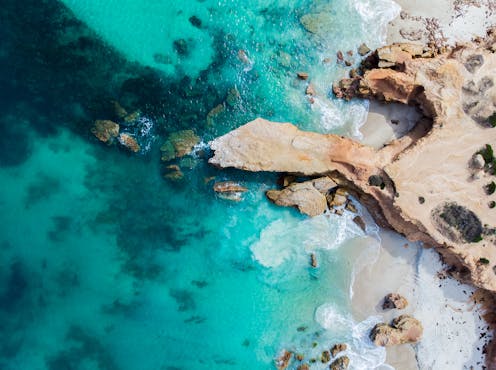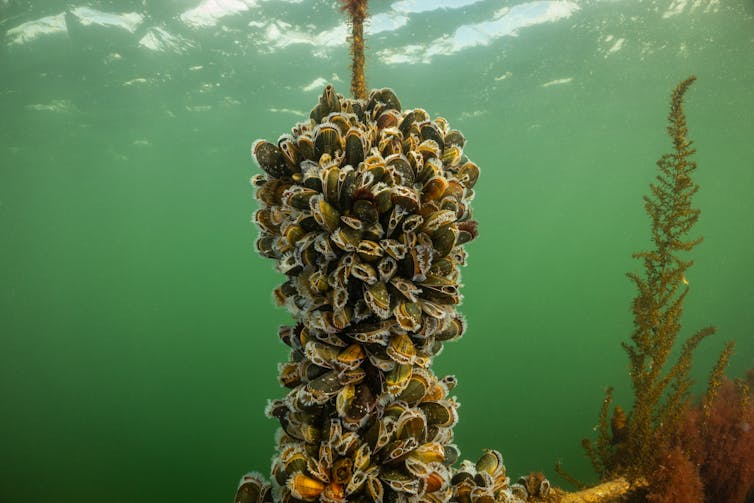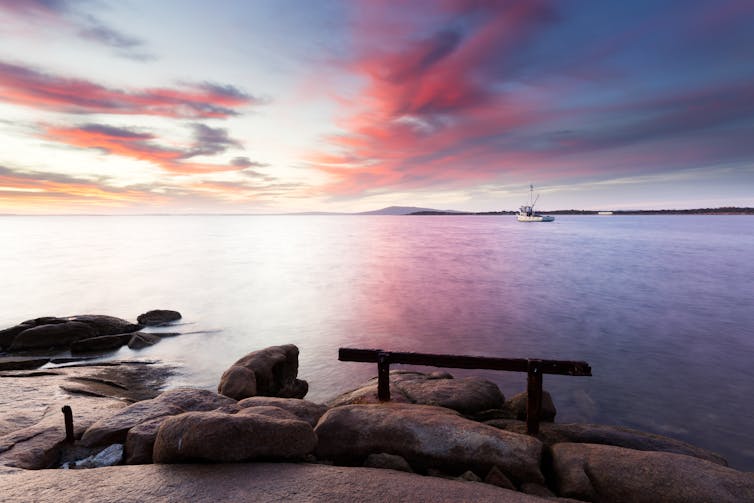 Gonzalo Buzonni/Shutterstock
Gonzalo Buzonni/ShutterstockFrom around 1996 to 2010, Australia was gripped by the millennium drought. As water shortages bit hard, most of Australia’s capital cities built large seawater desalination plants – Sydney, Adelaide, Brisbane, Melbourne and Perth. Remote towns have also built smaller desalination plants.
Most cities didn’t actually use them much. The drought broke in 2010, and desalinated water is expensive. The exception is Perth, which has been hit by declining rainfall, a drying climate and overuse of groundwater. The city will soon open its third desal plant.
As climate change intensifies, other states are also looking to build more desal plants. In South Australia, for instance, there are plans to build one urgently in response to looming water shortages. The Eyre Peninsula, for instance, is expected to run out of drinking water within two years as groundwater runs dry.
But beyond the expense, many of these plants bring environmental problems of their own.
How does desal work?
A desalination plant pipes in seawater, filters out the salt (usually using a process called “reverse osmosis”), and then flushes the salt back out to sea. This creates plumes of hyper-salty brine.
If you position a desal plant near a strong current, this isn’t a big issue – the salt is quickly diluted. But if you pump brine into a gulf or bay without much natural turnover of water, it can lay waste to entire ecosystems. And unfortunately, South Australia has two large gulfs – and two planned desal plants that could kill off giant cuttlefish or decimate mussel farms.
 Mussel farms are vulnerable to brine flows.
Drew McArthur/Shutterstock
Mussel farms are vulnerable to brine flows.
Drew McArthur/Shutterstock
When BHP Billiton was looking to expand its lucrative Olympic Dam uranium and copper mine in the mid-2000s, it had a problem: not enough water. To solve it, the mining giant announced plans to build a desal plant at Point Lowly, in the upper Spencer Gulf.
This was immediately controversial. Point Lowly is very close to the breeding grounds of the famous giant Australian cuttlefish (Sepia apama), a tourist drawcard.
My research suggested the brine outflow from the desal plant would cause environmental harm to these spectacular breeding grounds.
Despite environmental concerns, the Olympic Dam expansion was eventually approved in 2011, and the approval for the Point Lowly desal plant carried forward to the new Northern Water partnership between the state government and the private sector, which involves BHP as a key player.
This, the government states, is designed to:
provide a new, climate independent water source for the Far North, Upper Spencer Gulf and Eastern Eyre Peninsula regions of South Australia, to enable the growth of industries crucial to achieving net-zero goals, including the emerging green energy and hydrogen industries
The government recently changed the preferred location to Cape Hardy, much further down the Spencer Gulf. From as early as 2028, it will produce up to 260 million litres (megalitres) of desalinated water a day for use in mining and green industries.
A separate smaller desal plant (24 megalitres a day) is also planned for Billy Lights Point near Port Lincoln, to provide water for the lower Eyre Peninsula.
If the government was hoping to avoid controversy by moving away from the cuttlefish, it did not succeed. Opposition has come from the local council, First Nations groups, and fishing and aquaculture industries.
The problem with the location at Billy Lights Point is, once again, what happens to the brine. Salty outflows could damage mussel farms, fisheries and ecosystems.
Super-salty brine is pollution
My research suggests these concerns are well founded.
While we might think brine is harmless – it’s salty, like the sea – this is not correct. Desalination produces brine that is twice as salty as seawater. When you pump it back into the sea, it can form a layer of heavier water that creeps along the seafloor as a so-called brine underflow.
Desal brine can be dangerous, especially in waters that don’t mix rapidly. Without sufficient mixing, the oxygen content of the brine underflow falls over time. Eventually, the brine underflow can turn into a dead zone where very little can survive.
Desalination plants also pump out harmful chemicals with the brine, including pre-treatment chemicals, anti-fouling agents, heavy metals, nutrients, organics, chlorine and acids.
This means we should think very carefully about where to build desalination plants. The Spencer Gulf is full of seagrass meadows, the nurseries of the sea, home to leafy seadragons, giant cuttlefish, king prawns and millions of larval and juvenile fish.
 The waters of the Spencer Gulf are often calm.
Charlie Blacker/Shutterstock
The waters of the Spencer Gulf are often calm.
Charlie Blacker/Shutterstock
The brine can degrade or even destroy marine ecosystems. In the Arabian Gulf, where about half the world’s desal plants are located, researchers have found the pulses of brine “greatly threatens sensitive species”.
Given this marine pollution, any move to discharge desal brine into calm seas that have high ecological significance and do not flush rapidly is extremely risky.
At present, South Australia’s two planned desal projects do not seem to properly value environmental principles.
For instance, while the large Northern Waters project lists Cape Hardy as the preferred site, Point Lowly is still on the list of options. This ignores previous evidence showing the Spencer Gulf flushes slowly, which means a higher risk of environmental damage. And Cape Hardy is still within valuable and vulnerable marine habitats.
The smaller Port Lincoln desalination plant is expected to be operational by 2026 on Billy Lights Point, which borders Proper Bay and Boston Bay in the lower Spencer Gulf.
These bays are ecologically important, as they provide safe havens to marine larvae. They’re also part of the region’s coastal upwelling, a vital source of nutrients for whales and tuna.
The proposed intake and discharge locations of the Port Lincoln plant are within a few kilometres of valuable mussel and tuna farming operations.
Looking forward
While Cape Hardy is environmentally more suitable for desal discharge than Point Lowly, it is still within the sheltered waters of Spencer Gulf. Hence, some environmental degradation is likely to occur here as well.
If authorities are determined to stick with brine-releasing desal, they should urgently look at sites outside Spencer Gulf, such as Ceduna or Elliston. Here, brine would be quickly diluted by the currents.
But there are other options not yet considered.
It is likely we will need more desalination plants as climate change intensifies. The best solution is a desal plant fully powered by renewables – and without brine discharge. How? By cleaning the brine and turning it into a valuable product: salt.
Jochen Kaempf does not work for, consult, own shares in or receive funding from any company or organisation that would benefit from this article, and has disclosed no relevant affiliations beyond their academic appointment.

 6 months ago
81
6 months ago
81


